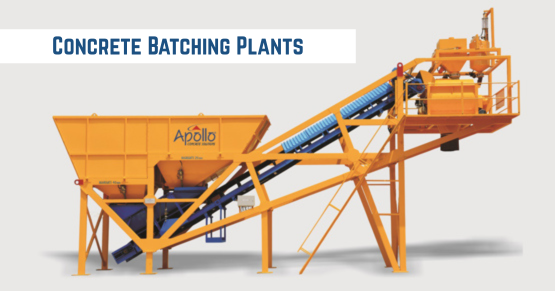Table of Contents
In the construction and infrastructure development industry, the significance of efficient and scalable concrete production systems remains indisputable. As urbanization expands and project complexities increase, the need for advanced concrete batching solutions continues to shape the operational strategies of major industry stakeholders. By 2030, the concrete batching plant market is expected to undergo a remarkable transformation, driven by advancements in automation, digital monitoring and modular design.
Concrete batching plants serve as the foundation for quality-controlled concrete production, playing a pivotal role in projects ranging from residential construction to large-scale industrial developments. With concrete batching equipment becoming more sophisticated, the ability to deliver high-volume, consistent mixtures in varied environmental conditions marks a new chapter in production efficiency.
Technological Integration in Modern Concrete Batching Systems
The integration of digital technologies is revolutionizing the way concrete batching systems operate. Smart sensors, programmable logic controllers (PLCs) and centralized monitoring software are enhancing batching accuracy and minimizing manual intervention. These systems may reduce material waste and streamline operational timelines, resulting in cost-effective project delivery.
Concrete batching machines equipped with real-time data acquisition tools enable operators to monitor moisture content, aggregate density and mix proportions without physical sampling. The reliability and traceability offered by such systems support quality assurance and reduce human error. These developments also pave the way for predictive maintenance protocols that may extend the lifecycle of concrete batching equipment while reducing unscheduled downtimes.
Advancements in Concrete Batching Plant Capacity and Scalability
Concrete batching plant capacity has long been a determining factor in plant selection and deployment. The market is now witnessing a shift toward modular and expandable plant configurations that allow businesses to adjust capacity based on project demands. Compact mobile batching plants with rapid setup features are gaining traction in areas where space or time constraints exist.
Larger stationary batching plants, on the other hand, are benefiting from upgrades in aggregate storage systems and high-capacity mixing units. These enhancements may enable a single plant to serve multiple construction sites simultaneously, without compromising output quality. Flexibility in plant capacity can empower operators to respond to fluctuating demands with agility.
Design Evolution in Concrete Batching Plant Infrastructure
Concrete batching plant design is evolving to accommodate faster throughput, reduced energy consumption and automated material handling. Conveyor systems, silo arrangements and aggregate bins are being re-engineered for optimized flow and minimal spillage. These structural refinements enhance productivity and contribute to safer working environments.
Furthermore, design improvements are not limited to hardware alone. Software-controlled batching systems are redefining plant layout optimization, allowing better synchronization between raw material input, mixing cycles and dispatch operations. These enhancements can support continuous production even in high-volume commercial projects, aligning with future-ready infrastructure goals.
Client Speaks
“We appreciate to Apolloinffratech for their batching plant as it made our work easy that helps to combine various ingredients to form concrete.”
Market Drivers Influencing the Demand for Concrete Batching Equipment
Several macroeconomic and sector-specific factors are contributing to the increasing demand for modern concrete batching equipment. Urban expansion, transportation infrastructure upgrades and industrial zone development are creating steady demand for high-quality concrete. Additionally, government investments in smart cities and affordable housing may continue to boost plant installations over the next decade.
Another emerging trend is the preference for turnkey concrete batching solutions that integrate equipment supply, installation, calibration and training. This bundled approach helps streamline procurement cycles and ensures consistent performance post-installation. As such, providers of comprehensive batching systems are poised to gain strategic advantages in this evolving market.
Regional Growth and Infrastructure-Driven Expansion Opportunities
Emerging economies across Asia, Africa and Latin America are witnessing increased infrastructure investments, leading to higher adoption rates of advanced concrete batching plants. Regional construction booms, coupled with favorable regulatory frameworks, are creating new avenues for plant deployment and market penetration.
In these regions, mobile batching plants may offer unique advantages by providing localized production capabilities in remote or undeveloped areas. This mobility allows concrete suppliers to reduce transportation delays and adapt to challenging site conditions. As road networks, airports and energy facilities expand, so does the relevance of scalable and efficient batching infrastructure.
Client Speaks
“We appreciate to Apolloinffratech for their batching plant as it made our work easy that helps to combine various ingredients to form concrete.”
Innovation in Concrete Batching Plant Automation and Control Systems
Automation stands at the core of the concrete batching evolution. Control systems are now engineered to automate mix sequence execution, raw material handling and quality checks. These capabilities may reduce labor dependency while ensuring uniformity across batches.
Programmable systems can incorporate external environmental data – such as humidity and temperature – into batching algorithms, ensuring the concrete’s consistency and strength are maintained regardless of weather variability. This level of control not only improves product quality but also aligns with project deadlines and regulatory compliance.
Long-Term Cost Optimization through Efficient Concrete Batching Systems
Modern batching systems may significantly lower operational costs through material optimization, energy-efficient drives and low-maintenance components. Real-time data analysis and automated dosing minimize excess usage of aggregates and admixtures, helping operators manage expenses effectively.
Moreover, the inclusion of recycling systems within batching plant design enables the reuse of wastewater and residual concrete. Although not a primary environmental strategy, such features may contribute to cost reduction by minimizing resource wastage and disposal charges.
Conclusion:
The concrete batching industry is on the cusp of a major transformation that extends beyond traditional infrastructure. The fusion of smart technologies, adaptable plant configurations and process automation is paving the way for higher operational excellence and market competitiveness. As global construction demands grow in complexity, the right concrete batching solutions will serve as the bedrock for resilient and future-proof project execution.
Table of Contents



